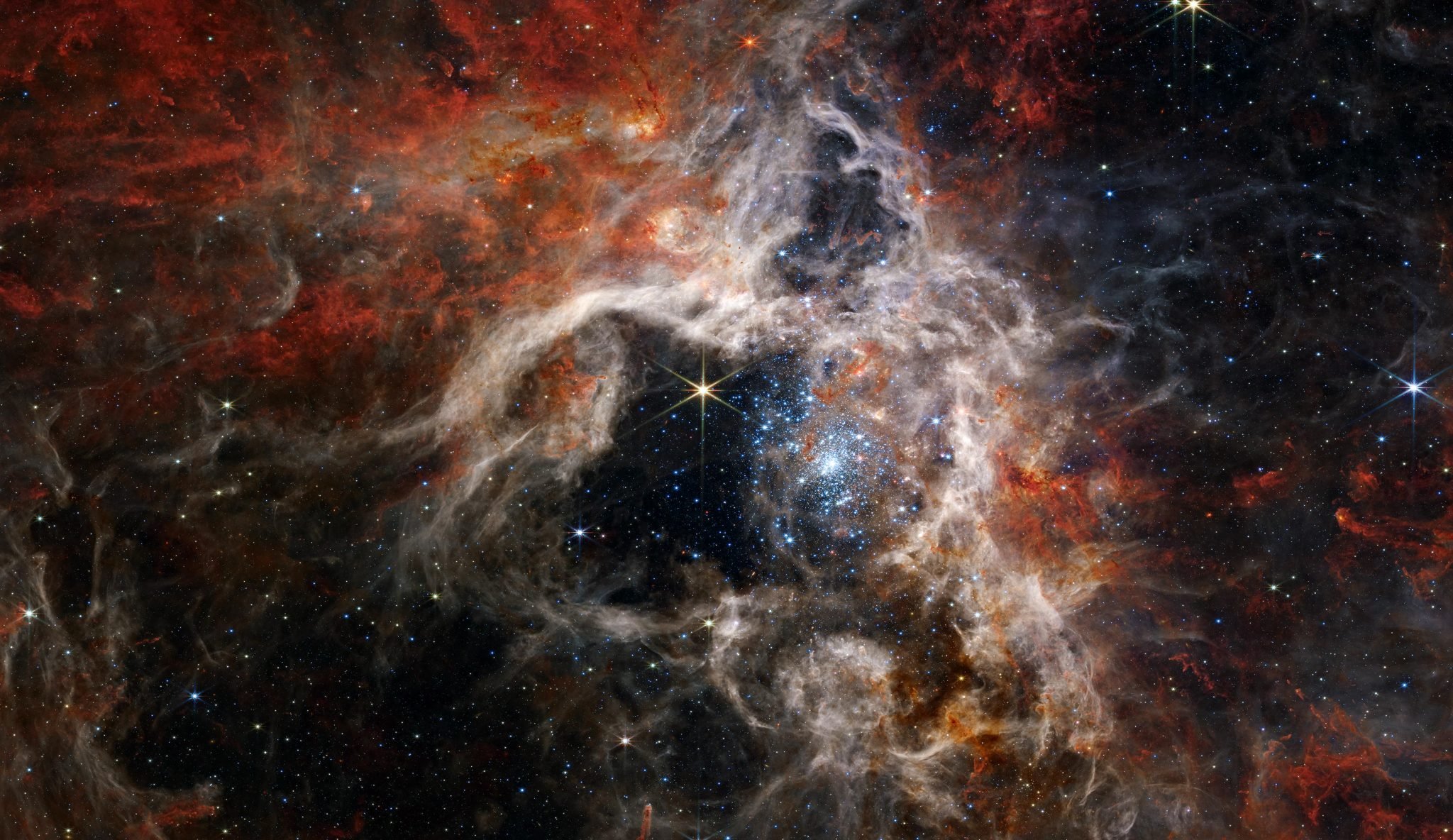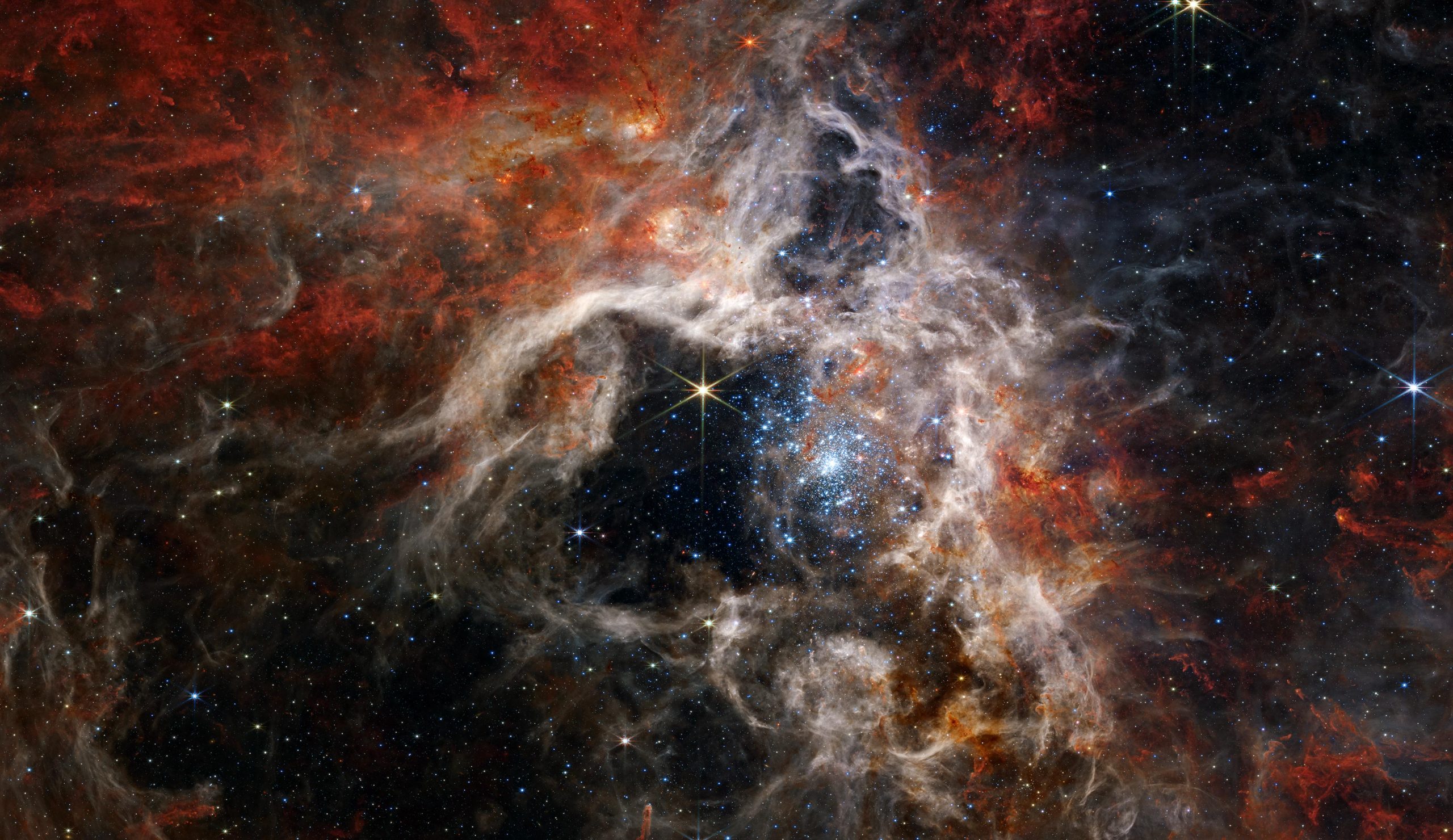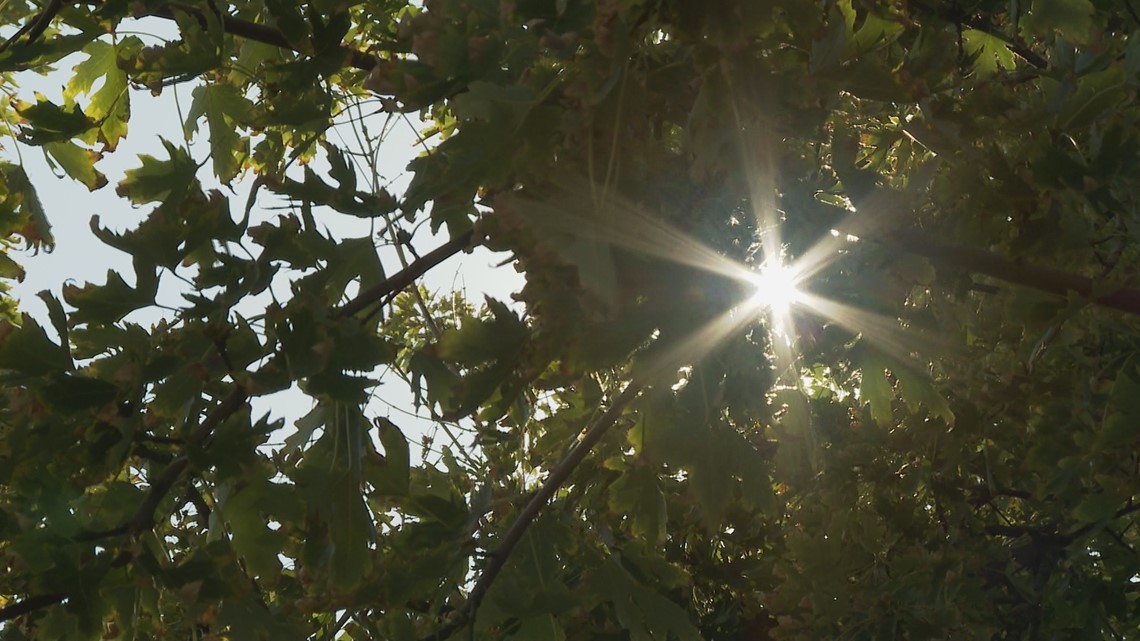
Die Nahinfrarot-Webkamera (NIRCam) hat dieses Mosaikbild mit einem Durchmesser von 340 Lichtjahren aufgenommen. Es zeigt die Sternentstehungsregion des Tarantelnebels in einem neuen Licht, einschließlich Zehntausender junger, nie zuvor gesehener Sterne, die zuvor von kosmischem Staub umgeben waren. Die aktivste Region erscheint blassblau und scheint von massiven jungen Sternen zu funkeln. Und dazwischen verstreut liegen noch vergrabene Sterne, die rot erscheinen, aber noch nicht aus dem Kokon des staubigen Nebels hervorkommen. NIRCam ist in der Lage, diese staubbedeckten Sterne dank beispielloser Genauigkeit bei Wellenlängen im nahen Infrarot zu erkennen.
Oben im Hohlraum des Nebels, oben links in einem jungen Sternhaufen, ist ein älterer Stern deutlich sichtbar, die acht charakteristischen Beugungsspitzen von NIRCam, ein Artefakt der Teleskopstruktur. Nachdem sich das obere Zentrum dieses Sterns nach oben erhebt, markiert es ungefähr eine deutliche Blase in der Wolke. Junge Sterne, die immer noch von staubiger Materie umgeben sind, blähen diese Blase auf und beginnen, ihren eigenen Hohlraum auszuhöhlen. Die Astronomen nutzten zwei Webb-Spektrometer, um diese Region genauer unter die Lupe zu nehmen und die chemische Zusammensetzung des Sterns und des ihn umgebenden Gases zu bestimmen. Diese spektralen Informationen informieren Astronomen über das Alter des Nebels und die Anzahl der Generationen von Sterngeburten, die er erlebt hat.
Weit entfernt von der Kernregion heißer junger Sterne verwandelt sich kühleres Gas in Rost und offenbart den Astronomen, dass der Nebel reich an komplexen Kohlenwasserstoffen ist. Dieses dichte Gas ist das Material, das zukünftige Sterne bilden wird. Wenn die Winde massereicher Sterne Gas und Staub wegfegen, sammelt sich ein Teil davon an und bildet mit Hilfe der Schwerkraft neue Sterne.
NIRCam wurde von einem Team der University of Arizona und des Advanced Technology Center von Lockheed Martin entwickelt.
Bildnachweis: NASA, ESA, CSA, STScI, Webb ERO-Produktionsteam
Eine neue Geschichte über die Sternentstehung entfaltet sich
James Webb Space Telescope presents a new perspective on the Tarantula Nebula, or 30 Doradus, a region well-known to astronomers studying star formation. Its nickname originated from its resemblance to the spider itself. However, in Webb’s view, the overall region takes on the appearance of a tarantula’s home—a burrow lined with its own spun silk. The Tarantula Nebula shelters thousands of young and still-forming stars, many revealed by Webb for the first time.
Working together, a range of Webb’s high-resolution infrared instruments reveal the stars, structure, and composition of the nebula with a level of detail not previously possible. Astronomers will use Webb throughout its mission to gain insight into star formation and the stellar lifecycle. The implications of this extend to our own star, the Sun, as well as the formation of the heavy chemical elements that are essential to life as we know it.

At the longer wavelengths of light captured by its Mid-Infrared Instrument (MIRI), Webb focuses on the area surrounding the central star cluster and unveils a very different view of the Tarantula Nebula. In this light, glowing gas and dust come forward as the young hot stars of the cluster fade in brilliance. Abundant hydrocarbons light up the surfaces of the dust clouds, shown in blue and purple. Much of the nebula takes on a more ghostly, diffuse appearance because mid-infrared light is able to show more of what is happening deeper inside the clouds. Still-embedded protostars pop into view within their dusty cocoons, including a bright group at the very top edge of the image, left of center.
Other areas appear dark, like in the lower-right corner of the image. This indicates the densest areas of dust in the nebula, that even mid-infrared wavelengths cannot penetrate. These could be the sites of future, or current, star formation.
MIRI was contributed by ESA and NASA, with the instrument designed and built by a consortium of nationally funded European Institutes (The MIRI European Consortium) in partnership with JPL and the University of Arizona.
Credit: NASA, ESA, CSA, STScI, Webb ERO Production Team
A Cosmic Tarantula, Caught by NASA’s Webb Space Telescope
Once upon a space-time, a cosmic creation story unfolded: Thousands of never-before-seen young stars were spotted in a stellar nursery called 30 Doradus, captured by NASA’s James Webb Space Telescope. Nicknamed the Tarantula Nebula for the appearance of its dusty filaments in previous telescope images, the nebula has long been a favorite for astronomers studying star formation. In addition to young stars, Webb reveals distant background galaxies, as well as the detailed structure and composition of the nebula’s gas and dust.
Located just 161,000 light-years away in the Large Magellanic Cloud galaxy, the Tarantula Nebula is the largest and brightest star-forming region in the Local Group, the galaxies nearest our Milky Way. It is home to the hottest, most massive stars known to astronomers. Three of Webb’s high-resolution infrared instruments were focused on the Tarantula. Viewed with Webb’s Near-Infrared Camera (NIRCam), the region resembles a burrowing tarantula’s home, lined with its silk. The nebula’s cavity centered in the NIRCam image has been hollowed out by blistering radiation from a cluster of massive young stars, which sparkle pale blue in the image. Only the densest surrounding areas of the nebula resist erosion by these stars’ powerful stellar winds, forming pillars that appear to point back toward the cluster. These pillars contain forming protostars, which will eventually emerge from their dusty cocoons and take their turn shaping the nebula.

Webb’s Near-Infrared Spectrograph (NIRSpec) reveals what is really going on in a fascinating region of the Tarantula Nebula. Scientists focused the powerful instrument on what looked like a small bubble feature in the image from Webb’s Near-Infrared Camera (NIRCam). However, the spectra reveal a very different picture from a young star blowing a bubble in its surrounding gas.
The signature of atomic hydrogen, shown in blue, shows up in the star itself but not immediately surrounding it. Instead, it appears outside the “bubble,” which spectra show is actually “filled” with molecular hydrogen (green) and complex hydrocarbons (red). This is an indication that the bubble is actually the top of a dense pillar of dust and gas that is being blasted by radiation from the cluster of massive young stars to its lower right (see the full NIRCam image). It does not appear as pillar-like as some other structures in the nebula because there is not much color contrast with the area surrounding it.
The harsh stellar wind from the massive young stars in the nebula is breaking apart molecules outside the pillar, but inside they are preserved, forming a cozy cocoon for the star. This star is still too young to be clearing out its surroundings by blowing bubbles – NIRSpec has captured it just beginning to emerge from the protective cloud from which it was formed. Without Webb’s resolution at infrared wavelengths, the discovery of this star birth in action would not have been possible.
NIRSpec was built for the European Space Agency (ESA) by a consortium of European companies led by Airbus Defence and Space (ADS) with NASA’s Goddard Space Flight Center providing its detector and micro-shutter subsystems.
Credit: NASA, ESA, CSA, STScI, Webb ERO Production Team
Webb’s Near-Infrared Spectrograph (NIRSpec) caught one very young star doing just that. Astronomers previously thought this star might be a bit older and already in the process of clearing out a bubble around itself. However, NIRSpec showed that the star was only just beginning to emerge from its pillar and still maintained an insulating cloud of dust around itself. This episode of star formation-in-action could not have been revealed, without Webb’s high-resolution spectra at infrared wavelengths.
When viewed in the longer infrared wavelengths detected by Webb’s Mid-infrared Instrument (MIRI), the region takes on a different appearance. The hot stars fade, and the cooler gas and dust glow. Within the stellar nursery clouds, points of light indicate embedded protostars, still gaining mass. While shorter wavelengths of light are absorbed or scattered by dust grains in the nebula, and therefore never reach Webb to be detected, longer mid-infrared wavelengths penetrate that dust, ultimately revealing a previously unseen cosmic environment.
One of the reasons the Tarantula Nebula is interesting to astronomers is that the nebula has a similar type of chemical composition as the gigantic star-forming regions observed at the universe’s “cosmic noon.” This was when the cosmos was only a few billion years old and star formation was at its peak. Star-forming regions in our Milky Way galaxy are not producing stars at the same furious rate as the Tarantula Nebula, and have a different chemical composition. This makes the Tarantula the closest (i.e., easiest to see in detail) example of what was happening in the universe as it reached its brilliant high noon. Webb will provide astronomers the opportunity to compare and contrast observations of star formation in the Tarantula Nebula with the telescope’s deep observations of distant galaxies from the actual era of cosmic noon.
Despite humanity’s thousands of years of stargazing, the star-formation process still holds many mysteries. Many of them are due to our previous inability to get crisp images of what was happening behind the thick clouds of stellar nurseries. Webb has already begun revealing a universe never seen before, and it is only getting started on rewriting the stellar creation story.
The James Webb Space Telescope is the world’s premier space science observatory. Webb will solve mysteries in our solar system, look beyond to distant worlds around other stars, and probe the mysterious structures and origins of our universe and our place in it. Webb is an international program led by NASA with its partners, ESA (European Space Agency) and the Canadian Space Agency.









